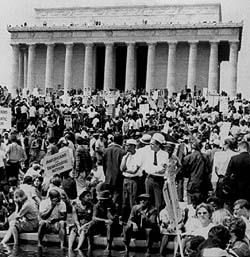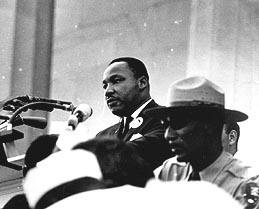|
...In spite of the difficulties of the moment, I still have a dream. It is a dream deeply rooted in the American dream. King's speech was the grand finale of the August 28, 1963,
"March on Washington for Jobs and Freedom." The march, led by union
leader A. Philip Randolph and organizer Bayard Rustin, drew 200,000
supporters, 50,000 of them white. They included clergy of every faith,
students, blue-collar and white-collar workers, and celebrities like
Harry Belafonte, Sammy Davis, Jr., Marlon Brando, James Garner, Joan
Baez, and Bob Dylan. Robert Weisbrot, author of Freedom Bound,
called the march "the largest political assembly in American history." On August 22, 2003 the Martin Luther King, Jr. Inscription Dedication unveiled the commemoration of the “I Have a Dream” speech with a keynote presentation by Coretta Scott King. The work, an inscription in the granite approach to the Lincoln Memorial, marks the location where Dr. King spoke to the crowd, which assembled for the March on Washington.
Of the other civil rights events at the Lincoln Memorial, perhaps none other has been as celebrated as the Easter Sunday 1939 concert by contralto Marian Anderson, who sang to 75,000 people gathered on the grounds. As an African American Anderson had previously been denied the right to perform at Constitution Hall, owned by the then all-white Daughters of the American Revolution (DAR). As a result First Lady Eleanor Roosevelt, who resigned from the DAR because of the incident, worked in tandem with the Marian Anderson Citizens Committe, the NAACP, and other artistic and civil rights organizations to arrange and publicized the Lincoln Memorial concert. The Lincoln Memorial, administered by the National Park Service, is located in West Potomac Park in Washington, D.C. and is open from 8:00 a.m. to 11:45 p.m., every day except Christmas. Call 202-426-6841, or click here for more information.
Itinerary Home | List of Sites | Main Map | Learn More | Next Site |
NEP
 Lincoln Memorial during the 1963 Civil Rights Protests
Lincoln Memorial during the 1963 Civil Rights Protests Martin Luther King, Jr., making his "I have a dream" speech
Martin Luther King, Jr., making his "I have a dream" speech